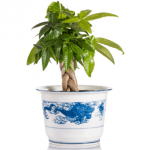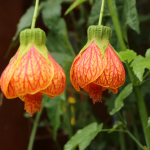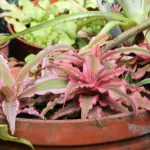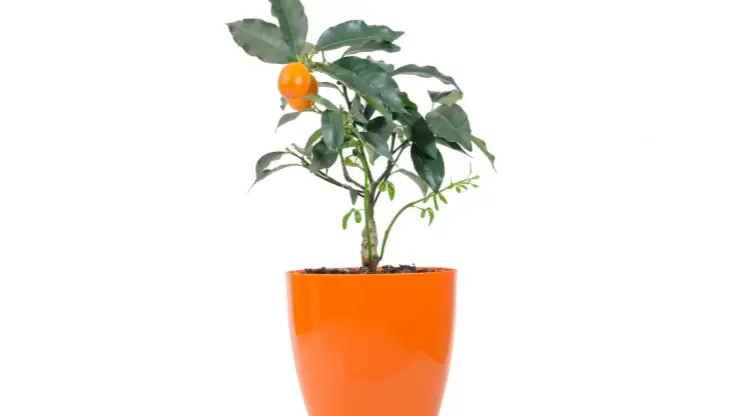
Calamondin orange (Citrus x citrofortunella mitis), also known as miniature orange, is one of the best citrus plants to grow indoors – as long as you have a sunny, south-facing window to provide plenty of light. It’s actually a cross between a kumquat and an orange.
The tree produces bright orange fruits around 1 inch (2.5 cm) wide, which you can use like lemons for cooking or make them into marmalade. The leaves also give off a pleasant citrus scent when crushed, and the flowers are slightly fragrant as well.
In this post, I’ll cover all aspects of Calamondin orange tree care indoors – including how to keep it happy and producing fruit for 10 years or more in your home.
Calamondin Orange Tree Care
Because of its high light requirements, I would place Calamondin orange tree in the “moderate difficulty” category. But if you provide enough sunlight, you’ll find it’s a relatively easy fruiting plant to grow. Here’s a run-down of care requirements:
- WATER: Moderate; water when the top 1 inch (2.5 cm) soil dries out
- HUMIDITY: Moderate
- FEEDING: Every two weeks to a month with a 7-3-3 citrus fertilizer
- LIGHT: Bright with 4 hours direct sunlight daily
- TEMPERATURE: 65 – 75 degrees F (18 – 24 degrees C)
- SAFETY: Leaves and flowers are toxic to cats and dogs
- DIFFICULTY: Moderate
This is a basic look at Calamondin orange tree care, but read on for more in-depth information, including potting, propagation, maintenance, and when/how to pick the fruit.
Water
Calamondin orange tree has moderate water needs. For the best results, water anytime the top of the potting soil becomes dry to a depth of 1 inch (2.5 cm). In spring and summer, you can keep the soil slightly moist at all times, but avoid water-logged soil.
Citrus trees are very sensitive to over-watering and can develop root rot if the soil is wet for too long. Make sure your plant’s container is propped up on feet or place on a tray filled with pebbles so that the pot never sits in water.
Humidity
Calamondin orange doesn’t have high humidity needs, but it will usually require some supplemental moisture. Mist your plant twice a week with a spray bottle filled with lukewarm water to keep it happy.
If you have very dry air in your home or run central heating in the winter, increase misting to every other day. You can also place the plant on a tray filled with pebbles and water, making sure the bottom of the pot doesn’t touch water. See my post on How to Make a Humidity Tray for Houseplants for more information.
Fertilizer
Feed your Calamondin orange tree once every two weeks during spring and summer with a fertilizer designed for citrus plants that includes micro-nutrients. In fall and winter, reduce feeding to once a month.
My favorite fertilizer for indoor citrus plants is this one by Happy Frog. But any food will work as long as it has a 7-3-3 ratio and includes active soil microbes for improved nutrient uptake. This will increase the number and quality of fruit your tree produces.
Light
Light is the most important aspect of Calamondin orange tree care. This plant requires as much sunlight as you can give it, including at least 4 hours of direct sunlight every day. A sunny, south-facing window is the ideal location.
Need companion plants for your Calamondin orange? See my post 25 Best Houseplants for South Facing Windows for more ideas.
Temperature
Give your Calamondin orange tree average room temperatures of 65 – 75 degrees F (18 – 24 degrees C) all year for the best results. It can tolerate cooler temperatures of 60 degrees F (16 degrees C) in winter and warmer temperatures of 80 degrees F (27 degrees C) in summer.
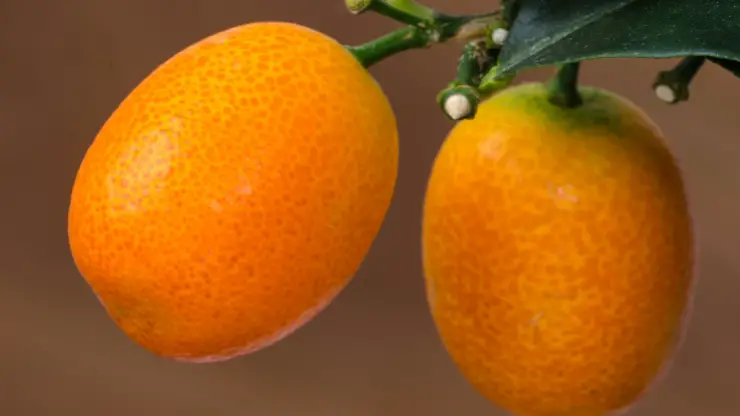
Potting
Plant Calamondin orange in any high-quality potting soil with good water retention. My favorite is this one by Happy Frog because it contains mycorrhizal fungi and beneficial soil microbes, but any good potting mix will work.
Re-pot young plants once every two years. Once your plant is 3 – 4 years old and fills an 8-inch (20-cm) pot, you’ll only need to re-pot once every two or three years. When plants need re-potting, shift to a container with a diameter 4 inches (10 cm) larger than the previous pot.
Propagation
Calamondin orange is easy to propagate from cuttings. Root 4 inch (10 cm) stem cuttings in early summer. Use rooting powder and keep the cuttings in a plastic bag to maintain high humidity levels. Cuttings will root in about 6 to 8 weeks.
Maintenance
Keep older Calamondin orange trees compact by pruning back any long branches in the spring, before new growth begins. New branches will grow from where the older ones are pruned back. To ensure fruit, dab flowers with a dry paintbrush to distribute pollen among them.
You may also need to clean the plant’s leaves with a damp, soft cloth periodically to remove dust and keep the plant free of pests. See my post on How to Clean Your Houseplant’s Leaves for more information on this topic.
Troubleshooting
Here are some common problems indoor gardeners often have with Calamondin orange tree, plus tips on how to fix them.
- Tree Doesn’t Bloom – If your Calamondin orange tree doesn’t bloom, it’s because the pot is too large or the plant is over-fertilized. Keep young plants in pots no longer than 6 inches (15 cm) in diameter across. Reduce feeding to once every two weeks in spring and summer, and once every month in fall and winter.
- Tree Does Not Produce Fruit – If your Calamondin orange tree doesn’t produce fruit, or the flowers drop without setting fruit, it’s most likely due to dry air or your plant may need to be pollinated. Increase humidity near your plant by misting regularly, and dab the flowers with a dry paintbrush to distribute pollen among them.
- Leggy Calamondin Orange Tree – If your tree becomes leggy, it needs to be pruned back. To keep the plant compact, prune back long branches in spring before new growth begins. New branches will grow from where the older ones were clipped back.
Related Questions
Here are some frequently asked questions regarding Calamondin orange tree care that you might find helpful (plus my answers to them).
Can You Eat a Calamondin Orange?
Yes, you can eat Calamondin oranges. However, they can taste tart when eaten whole. The best use for them is in cooking anywhere you would use lemons or to make marmalade, where extra sugar is added. Before using the rinds in cooking, taste for bitterness first.
When Do You Pick Calamondin Oranges?
Calamondin orange trees produce fruit beginning in their second year nearly year-round (as long as you’re caring for the tree properly and giving it plenty of light). You can pick them once they reach 1 inch (2.5 cm) wide and become bright orange in color.
There’s no rush to pick Calamondin oranges, as they stay in great condition on the plant for several weeks. Just to be sure, I would pick them within two weeks of reaching full ripeness.
How Tall Does Calamondin Orange Tree Get Indoors?
Calamondin orange tree reaches 36 inches (90 cm) in height indoors when given adequate light. It’s a great choice for a large, south-facing window plant.
Where to Buy Calamondin Orange
Although it’s possible to find Calamondin orange tree for sale in some states, it’s more often purchased via mail order. You can also grow one from a cutting taken from a friend’s tree (see propagation instructions above).
To prevent citrus canker and some plant viruses, live Calamondin orange trees cannot be shipped to Arizona, California, Florida, or Texas. If you live in one of these states, you’ll have to shop locally at nurseries or garden centers.
If you live in any other state, my favorite place to purchase plants online is Etsy. Small growers care more about the quality of their plants than large online nurseries. Plus, you can find plants in different sizes to fit any budget – from tiny rooted cuttings to full-size fruiting trees.
Click here to check the current Etsy listings for Calamondin orange trees. Good luck and happy growing!

